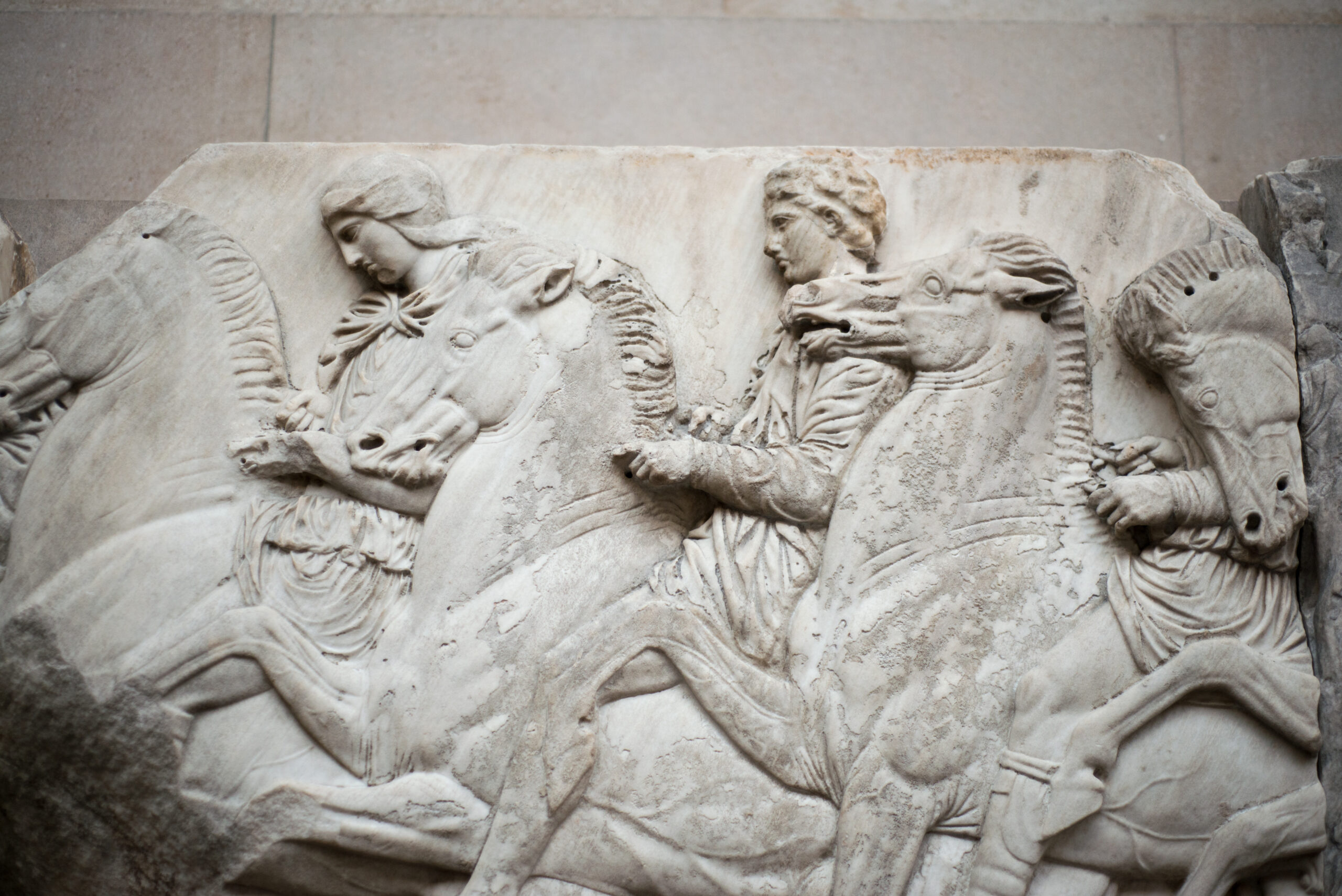Stolen artifacts and the need to return them to their origin country has been a topic in the international community for some time. In 2021, U.S. craft store Hobby Lobby found itself in hot water after it was discovered it had purchased an Iraqi artifact that had been stolen during the Iraqi conflict then illegally smuggled into the United States.[1] Hobby Lobby was forced to forfeit the artifact along with hundreds of others so that the U.S. government could return them to Iraq.[2] The British Museum also holds many artifacts that are arguably stolen, but the museum simply refers to them as “contested objects.”[3] Some of these contested objects include the Parthenon Sculptures, which since 1983, the Greek government has been asking to be returned to Greece.[4] The Parthenon Sculptures were taken from Greece in the early 1800s with permission from the Ottoman Empire, the governing authority in Athens at the time.[5] Recently, there have been whispers that the Parthenon Sculptures will return to Greece, but only on loan from the British Museum who still claims ownership over the sculptures.[6] This has opened the discussion on stolen art and artifacts, as well as the measures taken to return them to their original countries.
During World War II, the Nazis targeted and stole art from private Jewish collections, public museums, and organizations they deemed to be at odds with the Nazi ideology.[7] The movie, Woman in Gold, follows the true story of Maria Altmann and her attempt to regain possession of her family’s famous Klimt painting.[8] Altmann prevailed in her case against the Austrian government, with the U.S. Supreme Court decision stating that she was able to sue for ownership.[9] The Austrian government wanted to avoid this and the ownership of the piece was decided by arbitration in Austria, with the decision being to return all of Altmann’s paintings to her.[10] Arbitration is a more recent solution to this issue, previously following World War II, the Constitution of the United Nations Educational, Scientific and Cultural Organization (UNESCO) was created.[11] The idea behind UNESCO was that cultural property deserved international protection.[12]
At the 1954 Hague Convention, the Protocol for the Protection of Cultural Property in the Event of Armed Conflict was adopted.[13] The protocol defined cultural property as “moveable or immoveable property of great importance to the cultural heritage of every people.”[14] Archaeological sites, works of art, manuscripts, and monuments of architecture, art or history are expressly included in that definition.[15] In 2017, the United Kingdom ratified this convention.[16] However, this convention does not apply to the Parthenon Sculptures because they were not taken from Greece during an armed conflict.
There are two more recent conventions that were created in order to fill some of the holes left by the 1954 convention. The first is the 1970 Convention on the Means of Prohibiting and Preventing the Illicit Import, Export and Transfer of Ownership of Cultural Property.[17] The purpose of this convention was to prevent and reduce theft and illicit transfer of cultural objects.[18] This convention only applies to museums and similar institutions, not private parties.[19] The second convention is the UNIDROIT 1995 Convention on Stolen or Illegally Exported Cultural Objects, which establishes that a possessor of a cultural object that has been stolen should return it.[20] The 1995 convention also established a time limit for placing a request for restitution or return.[21] Unfortunately, neither of these conventions apply retroactively and they cannot be used to force the British Museum to return any of their contested objects.[22]
At this time, it seems the only way the Parthenon Sculptures will return to Greece is on loan from the British Museum. International legal expert Catharine Titi wrote in an opinion piece that a loan of the sculptures is not a repatriation and that Greece cannot accept it as it would establish the British Museum’s ownership of them.[23] Titi believes the best thing the British Museum can do at this point is return the sculptures to Greece, permanently.[24] Even British reporters agree, one going as far to tell the Museum to “stop dithering” and give the sculptures back.[25] While the British Museum can cling to their contested objects and dreams of colonialism past, they need to return the Parthenon Sculptures and all of the other stolen objects to the counties that have requested. While the damage of colonialism has already been done, the repatriation of these stolen objects would allow for the reclaiming of their origin country’s cultural history.
[1] Caroline Dumoulin, The Law on Looting – Repatriation of Stolen Artifacts to Their Countries of Origin, GW Law: Int’l L. and Pol’y Brief (Oct. 26, 2021), https://studentbriefs.law.gwu.edu/ilpb/2021/10/26/the-law-on-looting-repatriation-of-stolen-artifacts-to-their-countries-of-origin/.
[2] Id.
[3] Contested objects from the collection, The British Museum, https://www.britishmuseum.org/about-us/british-museum-story/contested-objects-collection.
[4] Id.
[5] Id.
[6] Catharine Titi, Debate: Sorry, British Museum, a loan of the Parthenon Marbles is not a repatriation, The Conversation (Feb. 15, 2023), https://theconversation.com/debate-sorry-british-museum-a-loan-of-the-parthenon-marbles-is-not-a-repatriation-199468.
[7] Looted Art, United States Holocaust Memorial Museum, https://www.ushmm.org/collections/bibliography/looted-art.
[8] Nina Totenberg, After Nazi Plunder, A Quest to Bring Home The ‘Woman in Gold’, NPR (Apr. 2, 2015), https://www.npr.org/2015/04/02/396688350/after-nazi-plunder-a-quest-to-bring-the-woman-in-gold-home.
[9] Id.
[10] Id.
[11] Francesco Francioni, Cultural Heritage, Oxford Pub. Int’l L. (database updated Nov. 2020).
[12] See Dumoulin, supra note 1.
[13] Michael W. Taylor, Evolving International Law for the Protection of Art, 2 N. Carolina J. Int’l L.131, 133 (1977).
[14] Id.
[15] Id.
[16] UNESCO, States Parties, https://en.unesco.org/protecting-heritage/convention-and-protocols/states-parties.
[17] Dumoulin, supra note 1.
[18] See Francioni, supra note 11.
[19] Id.
[20] Id.
[21] Id.
[22] See Dumoulin, supra note 1.
[23] See Titi, supra note 6.
[24] Id.
[25] Andrew Marr, Stop dithering, British Museum – give the Elgin Marbles back, The New Statesman (Jan. 10, 2023) https://www.newstatesman.com/culture/2023/01/andrew-marr-elgin-marbles-greece-british-museum.


